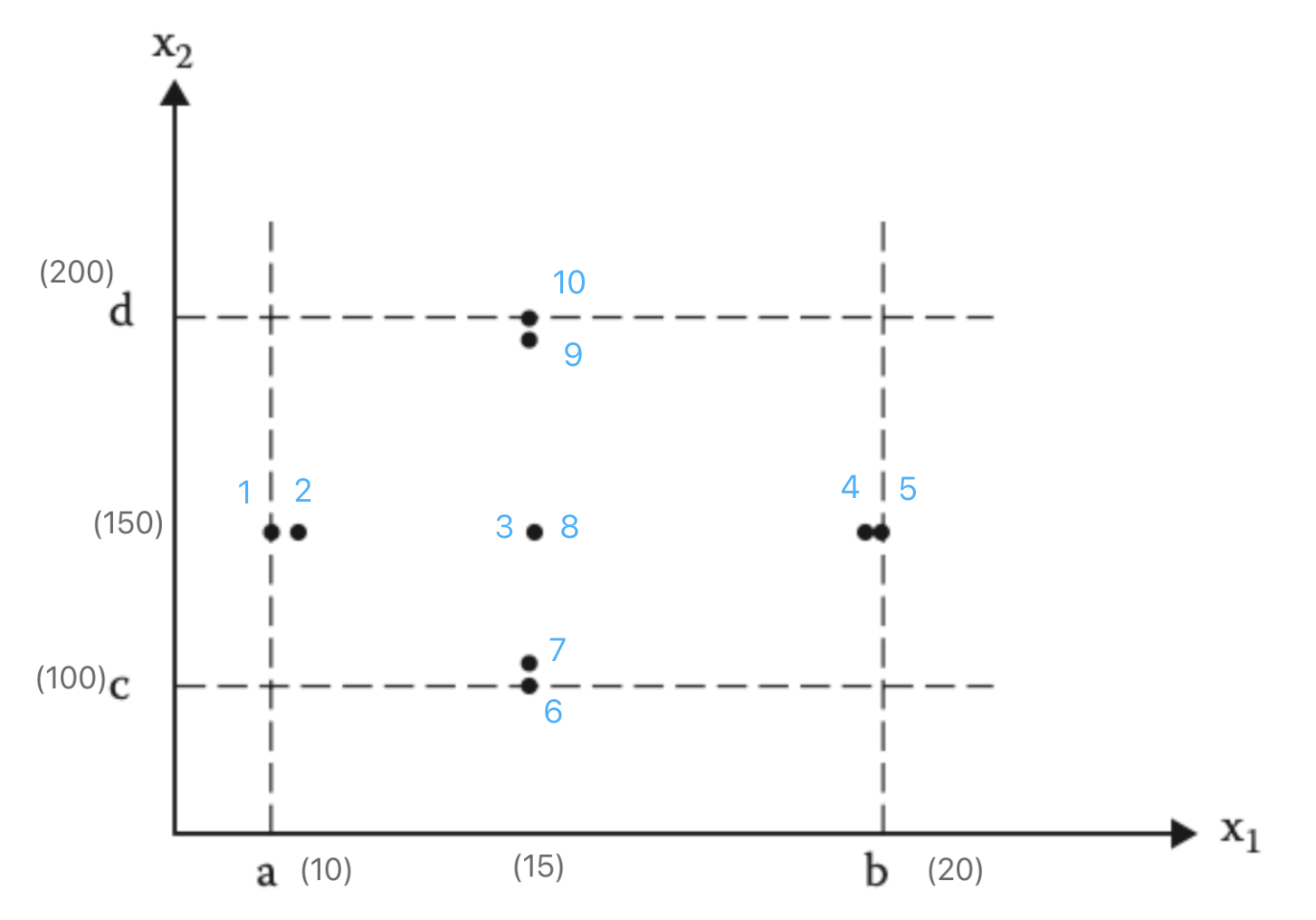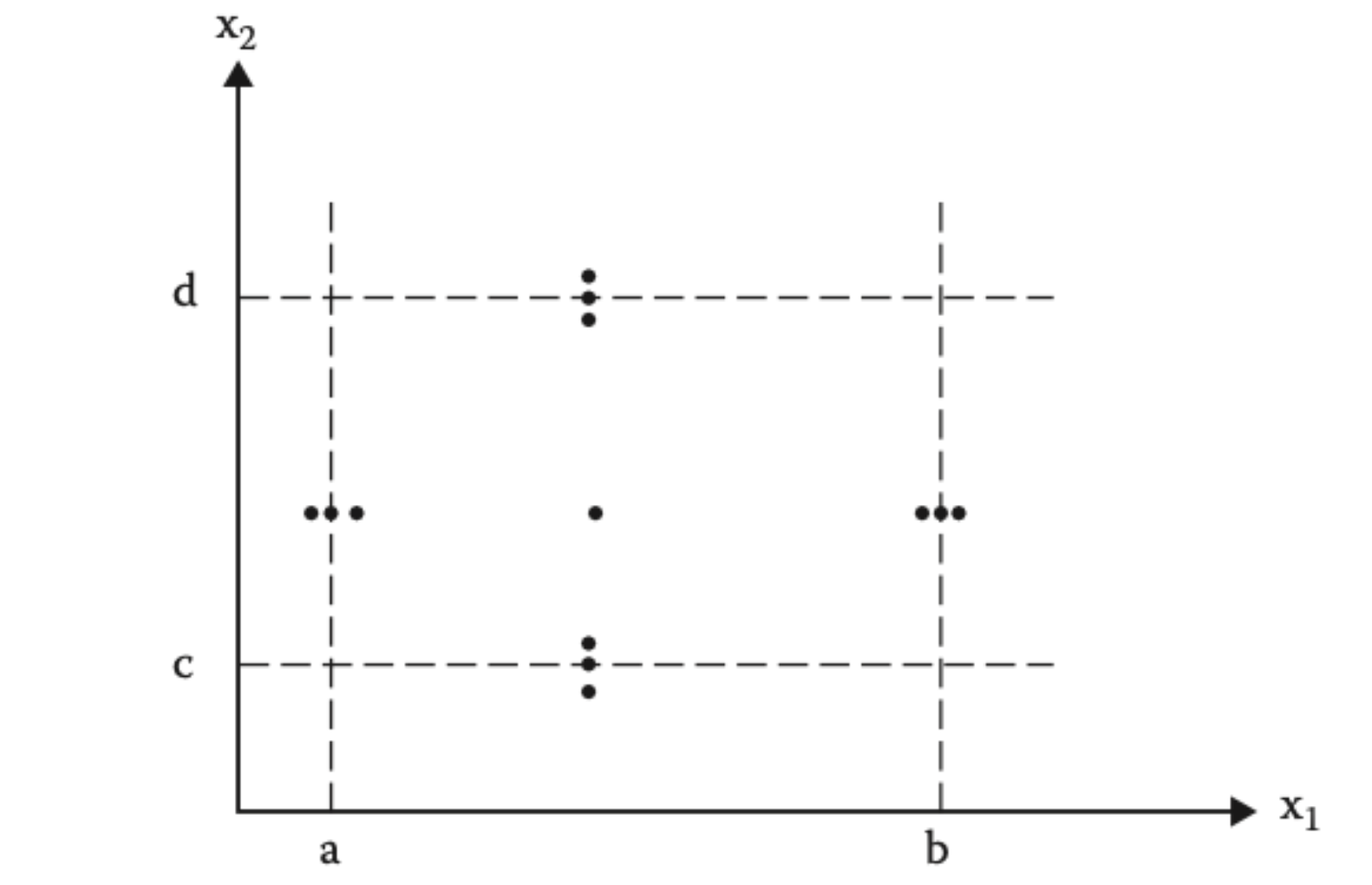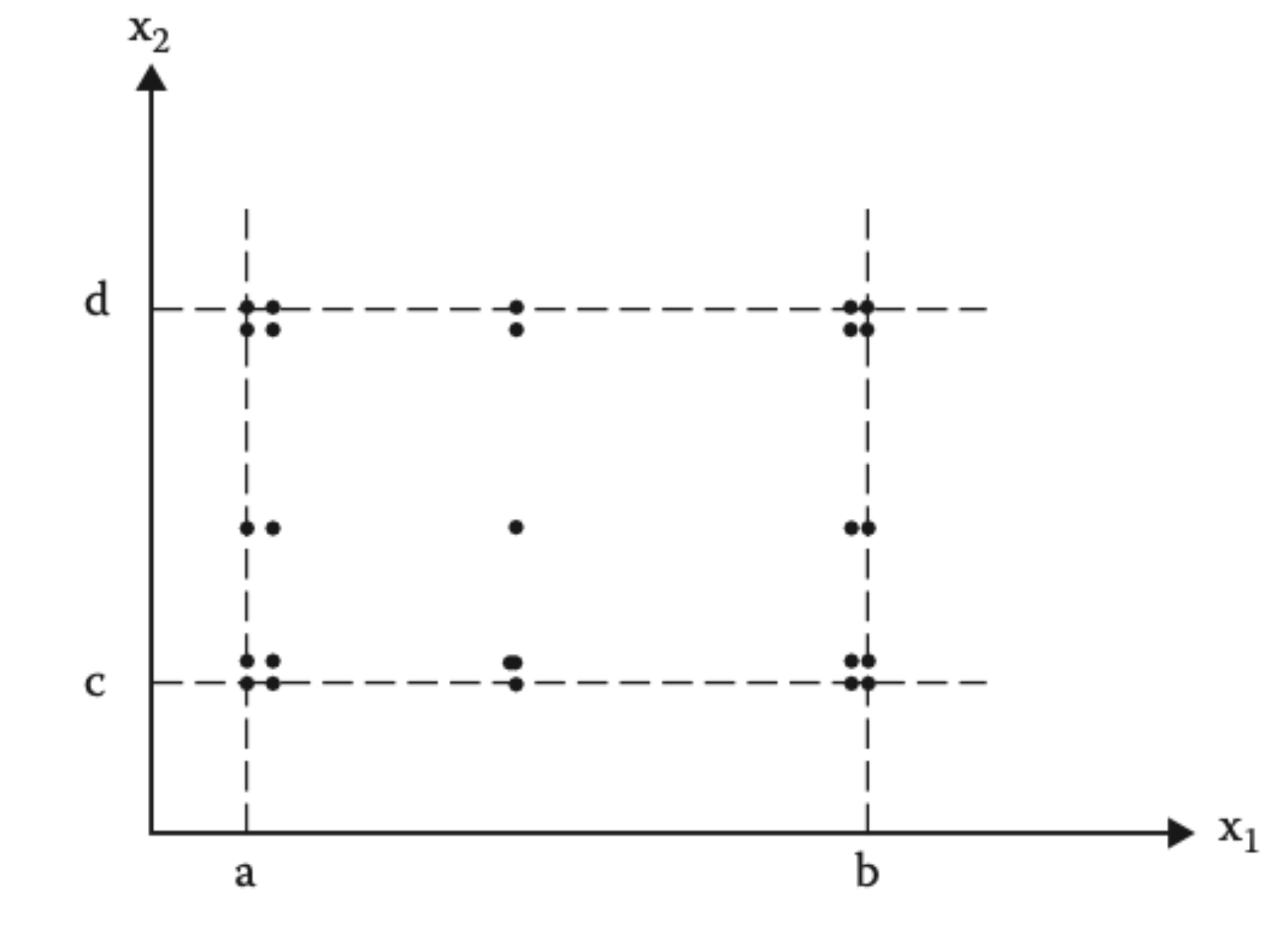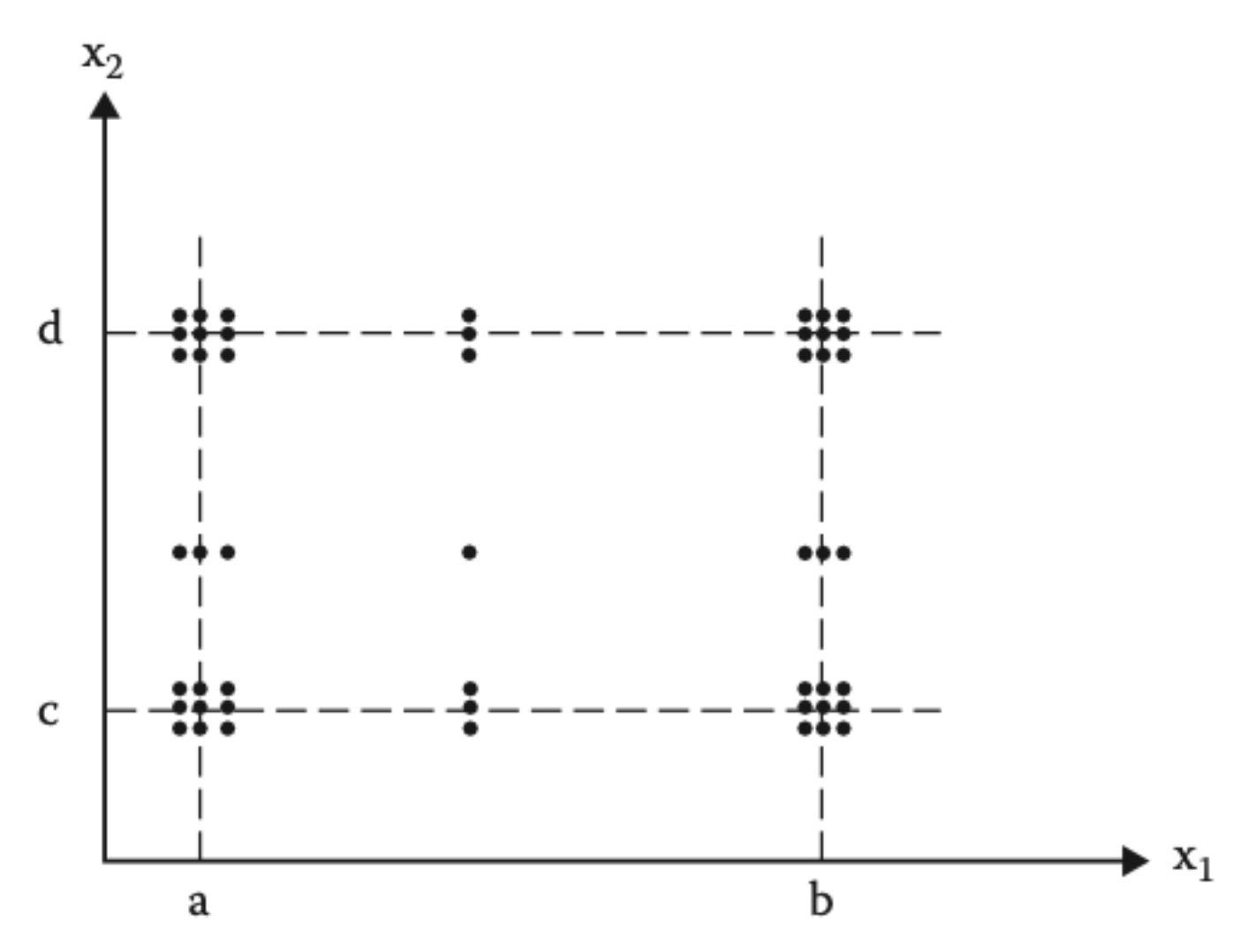Boundary Value Testing is based on the idea that - Bugs are more likely to occur at the “boundaries” of input ranges than in the middle.
Boundary Value Weak test design uses the following inputs
- Minimum (min)
- Just above minimum (min+)
- A nominal value (nom, a typical or middle value within the valid range)
- Just below maximum (max-)
- Maximum (max)
Knowledge in Assumptions of Blackbox Testing is required.
Basic types of boundary value test
Equivalence partitioning can be applied with different assumptions based on whether fault interaction is expected and whether invalid inputs are possible.
| Normal | Robust | |
|---|---|---|
| Weak | (best case) | |
| Strong | (worst case) |
- Weak Normal: Best case
- Weak: No interactions between parameters
- Normal: Only valid input values are considered, you are not dealing with complex invalid input
- Strong Robust: Worst case
- Strong: Interactions between parameters
- Robust: You have to consider invalid inputs
Single parameter weak normal boundary value
In this test case design, we assume:
- Weak: Each parameter is independent, only one input value causes bug at a time
- Normal: Only valid value is tested
Say we have a single parameter x1, which is valid in some range [a, b] . That is, a ≤ x1 ≤ b.
 So, we will have the following values for x1.
So, we will have the following values for x1.
- min:
a - min+:
a+1(or with smallest delta, a + delta) - nom:
a < nom < b - max-:
b-1(or with smallest delta b - delta) - max:
b
For example:
a = 10
b = 20
So, valid range: 10 ≤ x1 ≤ 20
Test inputs to use:
| Label | Value | Explanation |
|---|---|---|
min | 10 | Lower boundary |
min+ | 11 | Just above lower boundary |
nominal | 15 | A mid-range value (a < nom < b) |
max- | 19 | Just below upper boundary |
max | 20 | Upper boundary |
Single parameter weak robust boundary value
In this test case design, we assume:
- Weak: Each parameter is independent, only one input value causes bug at a time
- Robust: Invalid value exists
In this case, invalid values are allowed, so we have to test values out of bound
- min-:
a-1(or with smallest delta, a - delta) - min:
a - min+:
a+1(or with smallest delta, a + delta) - nom:
a < nom < b - max-:
b-1(or with smallest delta b - delta) - max:
b - max+:
b+1(or with smallest delta b + delta)
Two parameter weak normal boundary value
In this test case design, we assume:
- Weak: Only one input causes a fault at a time, so we only vary one parameter at a time, and keep the other at a nominal value.
- Normal: All inputs are valid
Let’s say the function takes two inputs: x1 and x2, where:
10 ≤ x1 ≤ 20100 ≤ x2 ≤ 200We only vary one parameter at a time (test boundary value of each input independently), while holding the other input at its nominal (typical) value. We choose:- For
x1:min= 10,min+= 11,nom= 15,max-= 19,max= 20 - For
x2:min= 100,min+= 101,nom= 150,max-= 199,max= 200 Step 1: Hold
Step 1: Hold x2at nominal (150), varyx1across boundaries
| Test | x1 | x2 | Notes |
|---|---|---|---|
| 1 | 10 | 150 | min |
| 2 | 11 | 150 | min+ |
| 3 | 15 | 150 | nom |
| 4 | 19 | 150 | max- |
| 5 | 20 | 150 | max+ |
Step 2: Hold x1 at nominal (15), vary x2 across boundaries |
| Test | x1 | x2 | Notes |
|---|---|---|---|
| 6 | 15 | 100 | min |
| 7 | 15 | 101 | min+ |
| 8 | 15 | 150 | nom |
| 9 | 15 | 199 | max- |
| 10 | 15 | 200 | max+ |
Two parameter weak robust boundary value
In this test case design, we assume:
- Weak: Only one input causes a fault at a time, so we only vary one parameter at a time, and keep the other at a nominal value.
- Robust: Invalid value exists, in addition to valid boundary values
Similar to previous test case design, let’s say the function takes two inputs: x1 and x2, where:
10 ≤ x1 ≤ 20100 ≤ x2 ≤ 200
This time, we test both valid and invalid boundary values for each parameter individually, while keeping the other parameter at a valid nominal value. We choose:
- For
x1:invalid below min= 9,min= 10,min+= 11,nom= 15,max-= 19,max= 20,invalid above max= 21 - For
x2:invalid below min= 99,min= 100,min+= 101,nom= 150,max-= 199,max= 200,invalid above max= 201

Step 1: Hold x2 at nominal (150), vary x1
| Test | x1 | x2 | Notes |
|---|---|---|---|
| 1 | 9 | 150 | Invalid (below min) |
| 2 | 10 | 150 | Valid (min) |
| 3 | 11 | 150 | Valid (min+) |
| 4 | 15 | 150 | Valid (nom) |
| 5 | 19 | 150 | Valid (max-) |
| 6 | 20 | 150 | Valid (max) |
| 7 | 21 | 150 | Invalid (above max) |
Step 2: Hold x1 at nominal (15), vary x2 |
| Test | x1 | x2 | Notes |
|---|---|---|---|
| 8 | 15 | 99 | Invalid (below min) |
| 9 | 15 | 100 | Valid (min) |
| 10 | 15 | 101 | Valid (min+) |
| 11 | 15 | 150 | Valid (nom) |
| 12 | 15 | 199 | Valid (max-) |
| 13 | 15 | 200 | Valid (max) |
| 14 | 15 | 201 | Invalid (above max) |
Two parameter strong normal boundary value
- Strong: All combinations of boundary values are tested together. That means we vary both parameters simultaneously at their boundary value.
- Normal: Only valid values are used (no invalid inputs).
Input ranges:
x1:10 ≤ x1 ≤ 20x2:100 ≤ x2 ≤ 200
We use only valid boundary values for both parameters:
- For
x1:min= 10,min+= 11,nom= 15,max-= 19,max= 20 - For
x2:min= 100,min+= 101,nom= 150,max-= 199,max= 200
We then test all combinations of the boundary values of x1 and x2 together.

| Test | x1 | x2 | Notes |
|---|---|---|---|
| 1 | 10 | 100 | Both at minimum |
| 2 | 10 | 101 | x1 at min, x2 at min+ |
| 3 | 10 | 150 | x1 at min, x2 at nom |
| 4 | 10 | 199 | x1 at min, x2 at max- |
| 5 | 10 | 200 | x1 at min, x2 at max |
| 6 | 11 | 100 | x1 at min+, x2 at min |
| 7 | 11 | 101 | x1 at min+, x2 at min+ |
| 8 | 11 | 150 | x1 at min+, x2 at nom |
| 9 | 11 | 199 | x1 at min+, x2 at max- |
| 10 | 11 | 200 | x1 at min+, x2 at max |
| 11 | 15 | 100 | x1 at nom, x2 at min |
| 12 | 15 | 101 | x1 at nom, x2 at min+ |
| 13 | 15 | 150 | x1 and x2 both at nom |
| 14 | 15 | 199 | x1 at nom, x2 at max- |
| 15 | 15 | 200 | x1 at nom, x2 at max |
| 16 | 19 | 100 | x1 at max-, x2 at min |
| 17 | 19 | 101 | x1 at max-, x2 at min+ |
| 18 | 19 | 150 | x1 at max-, x2 at nom |
| 19 | 19 | 199 | x1 at max-, x2 at max- |
| 20 | 19 | 200 | x1 at max-, x2 at max |
| 21 | 20 | 100 | x1 at max, x2 at min |
| 22 | 20 | 101 | x1 at max, x2 at min+ |
| 23 | 20 | 150 | x1 at max, x2 at nom |
| 24 | 20 | 199 | x1 at max, x2 at max- |
| 25 | 20 | 200 | Both at maximum |
Two parameter strong robust boundary value
- Strong: All combinations of boundary values are tested together. That means we vary both parameters simultaneously at their boundary value.
- Robust: Includes invalid values beyond the defined valid range.
Input Ranges:
-
x1:10 ≤ x1 ≤ 20 -
x2:100 ≤ x2 ≤ 200 -
For
x1:invalid below min= 9,min= 10,min+= 11,nom= 15,max-= 19,max= 20,invalid above max= 21 -
For
x2:invalid below min= 99,min= 100,min+= 101,nom= 150,max-= 199,max= 200,invalid above max= 201
| Test | x1 | x2 | Notes |
|---|---|---|---|
| 1 | 9 | 99 | Both invalid (below min) |
| 2 | 9 | 100 | x1 invalid, x2 at min |
| 3 | 9 | 101 | x1 invalid, x2 at min+ |
| 4 | 9 | 150 | x1 invalid, x2 at nom |
| 5 | 9 | 199 | x1 invalid, x2 at max- |
| 6 | 9 | 200 | x1 invalid, x2 at max |
| 7 | 9 | 201 | x1 invalid, x2 invalid (above max) |
| 8 | 10 | 99 | x1 at min, x2 invalid |
| 9 | 10 | 100 | Both at min |
| 10 | 10 | 101 | x1 at min, x2 at min+ |
| 11 | 10 | 150 | x1 at min, x2 at nom |
| 12 | 10 | 199 | x1 at min, x2 at max- |
| 13 | 10 | 200 | x1 at min, x2 at max |
| 14 | 10 | 201 | x1 at min, x2 invalid |
| 15 | 11 | 99 | x1 at min+, x2 invalid |
| 16 | 11 | 100 | x1 at min+, x2 at min |
| 17 | 11 | 101 | Both valid (min+, min+) |
| 18 | 11 | 150 | Valid (min+, nom) |
| 19 | 11 | 199 | Valid (min+, max-) |
| 20 | 11 | 200 | Valid (min+, max) |
| 21 | 11 | 201 | x1 valid, x2 invalid |
| 22 | 15 | 99 | x1 at nom, x2 invalid |
| 23 | 15 | 100 | x1 at nom, x2 at min |
| 24 | 15 | 101 | x1 at nom, x2 at min+ |
| 25 | 15 | 150 | Both nominal |
| 26 | 15 | 199 | x1 nom, x2 at max- |
| 27 | 15 | 200 | x1 nom, x2 at max |
| 28 | 15 | 201 | x1 nom, x2 invalid |
| 29 | 19 | 99 | x1 at max-, x2 invalid |
| 30 | 19 | 100 | x1 at max-, x2 at min |
| 31 | 19 | 101 | Valid |
| 32 | 19 | 150 | Valid |
| 33 | 19 | 199 | Valid |
| 34 | 19 | 200 | Valid |
| 35 | 19 | 201 | x2 invalid |
| 36 | 20 | 99 | x1 at max, x2 invalid |
| 37 | 20 | 100 | x1 at max, x2 at min |
| 38 | 20 | 101 | Valid |
| 39 | 20 | 150 | Valid |
| 40 | 20 | 199 | Valid |
| 41 | 20 | 200 | Both at max |
| 42 | 20 | 201 | x1 valid, x2 invalid |
| 43 | 21 | 99 | x1 invalid, x2 invalid |
| 44 | 21 | 100 | x1 invalid, x2 at min |
| 45 | 21 | 101 | x1 invalid, x2 at min+ |
| 46 | 21 | 150 | x1 invalid, x2 at nom |
| 47 | 21 | 199 | x1 invalid, x2 at max- |
| 48 | 21 | 200 | x1 invalid, x2 at max |
| 49 | 21 | 201 | Both invalid (above max) |
Back to parent page: Software Testing
Web_and_App_Development Software_Testing Blackbox_Testing SOFT3202 Boundary_Value_Test_Design